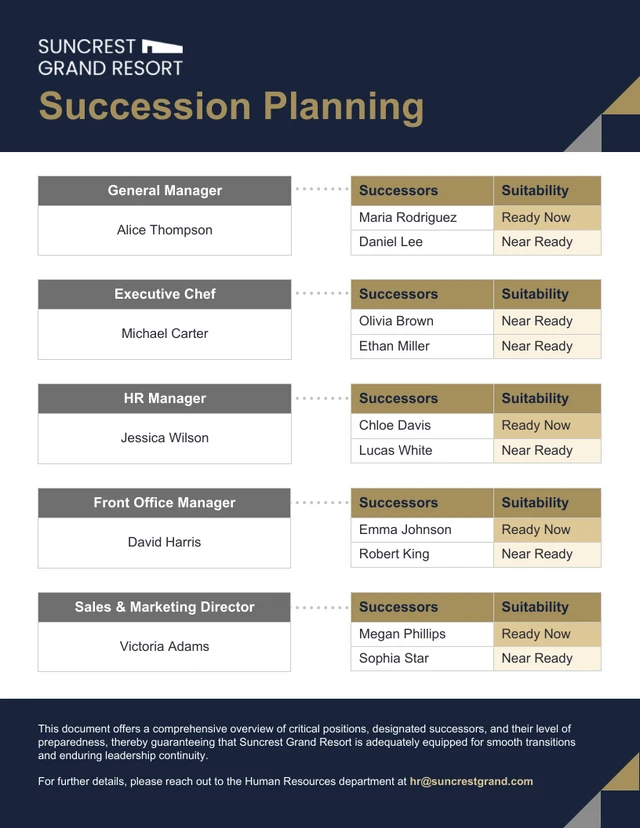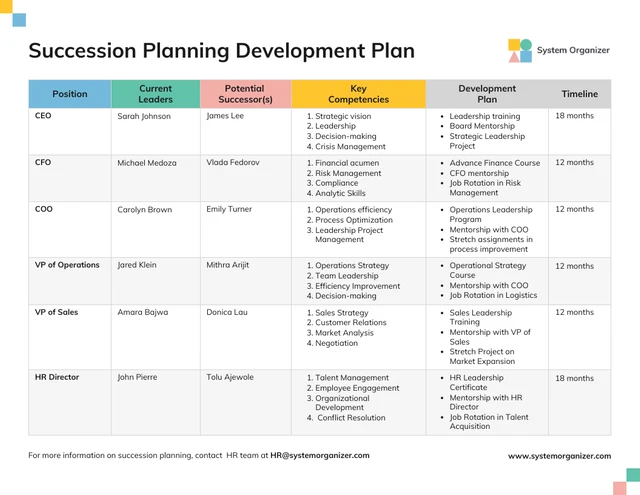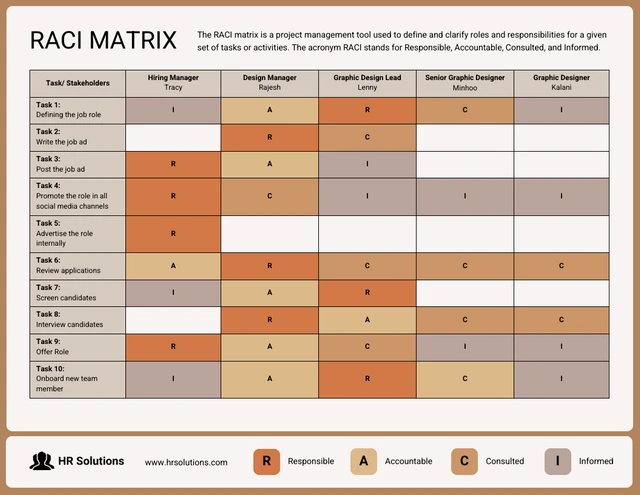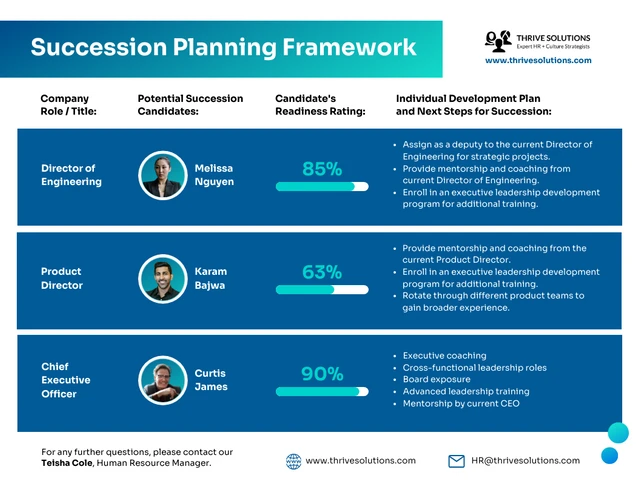
We often read news or hear stories from friends and family about how difficult it can be to land a new job. This means it’s easy for companies to find replacements when one is needed, right?
Not necessarily!
It’s true that most job openings draw many applicants, but finding the best fit is time-consuming, especially for leadership positions or roles vital for business success.
But what if there was a way to avoid the hassle of filtering through applications, interviewing, and hoping a hire works out?
Well, the good news is that it is possible with succession planning, a strategic process that involves identifying, developing, and preparing successors for key roles within an organization.
But surprisingly, only 35% of organizations have a succession planning process. Companies with poor or no succession planning strategy risk unexpected leadership vacancies, decreased morale, and loss of institutional knowledge. Ultimately, this impacts an organization’s ability to achieve goals and maintain competitive advantage.
Succession planning requires companies to put in the work creating plans tailored to their needs. But with Venngage, organizations can streamline the process using tools such as a free online report maker or customizable succession planning templates and human resources templates.
Stick around to the end of this blog to learn more about the succession planning process, how to build a culture of succession planning, and real-world examples that’ll show you why succession planning isn’t just a corporate buzzword.
Click to jump ahead:
- Understanding succession planning
- The succession planning process
- Building a succession planning culture
- Overcoming succession planning challenges
- Venngage’s succession planning templates
- Success stories
- Conclusion
Understanding succession planning
Succession planning may sound fancy and complicated, but it’s a relatively straightforward strategy.
Defining succession planning
Succession planning is the process organizations use to find and develop talent to fill leadership positions when incumbents leave or retire.
Companies do this to make sure there is a smooth transition during periods of transition to maintain operational efficiency.

Important: Succession planning is NOT the same as replacement planning. It’s easy to confuse the two concepts and while there is overlap, they’re two different processes.
Replacement planning is a reactive approach to filling a position in the short-term. It relies on promoting existing talent internally or hiring externally without focusing on individual development.
On the other hand, succession planning is a proactive approach to filling a position before there is even a vacancy available. The goal of this approach is to develop the skills and abilities of potential successors to ensure organizational success.
The goals of succession planning
On the surface, the goal of succession planning is to simply fill an empty position, but dig a little deeper, and you’ll realize that it’s a process to ensure organizational success, boost employee morale and improve retention.
“Since we started taking succession planning seriously, we have seen a noticeable improvement in employee morale and retention because people see a clear path for their future. Tools like TalentGuard and SAP SuccessFactors have helped us a lot by keeping everything organized and making it easy to track progress. These platforms allow us to monitor development plans, set clear goals, and ensure we’re staying on track.”
Sergey Taver, Marketing Manager, Precision Watches.
Here are the goals of succession planning:
- Leadership continuity: Ensure leadership positions are filled quickly to avoid disruptions.
- Talent development: Provide a framework for identifying and nurturing talent.
- Risk mitigation: Help organizations prepare for unexpected events, such as retirements, resignations, or health issues.
Here’s a sample succession planning template that a company might use to identify potential successors for different roles.
Successful succession planning not only requires a structured approach, but alignment with an organization’s overall business strategy.
To ensure alignment, here’s what organizations should do when creating succession plans:
- Identify critical roles: What positions are crucial to achieving the organization’s goals?
- Assess skills and competencies required: Once you’ve identified critical roles, assess what skills a person needs to succeed in it. This will help you determine the development needs of potential successors.
- Link development to objectives: Development activities should provide targeted training and development opportunities to equip successors with the skills and knowledge they need to succeed
“Since implementing our succession planning strategy two years ago, we’ve seen a 40% reduction in the time it takes to fill critical positions when they become vacant. Additionally, our retention rate for high-potential employees has improved by 25%, as they see clear career progression opportunities within the company.”
Mary Zhang, Head of Marketing and Finance, Dgtl Infra.
Don’t think succession planning is worth the effort? Here are a few examples of well-known companies that invest in this process:
- Walmart
- Microsoft
And many, many more!
The succession planning process
When done well, the succession planning process ensures you always have a pipeline of talent ready to lead the organization into the future.
The following steps is a basic framework any organization can follow to set up a succession planning system.
Step 1: Identify key positions
No two companies are the same. Even within the same industry, organizations face unique factors such as size, structure, and goals. Each of these will not only affect success but also guide succession planning strategies.
Hence, succession planning begins with companies doing internal reflection on qualifications or positions vital for its long-term success.
An easy way to determine which positions require building a roster of talent is to focus on C-suite roles like CEO, CFOs, and/or COO.
These roles usually impact the direction and performance of an organization and there’s no harm to focus on them first.
“We prioritize high-impact leadership and C-suite roles—these are the roles that drive our strategy and keep our operations humming. If our COO or Head of Production were suddenly unavailable, we’d feel the impact immediately. That’s why we focus on these positions in our succession planning.
Creating a solid plan starts with pinpointing the exact skills these roles need. In our industry, that means knowing everything from supply chain logistics to customer experience. We craft personalized development paths that mix real-world experience with leadership training—and we top it off with mentorship. Nothing beats learning from someone who’s been through the wringer.”
Michael Nemeroff, Co-founder & CEO, RushOrderTees.
But limiting your focus to only these roles is a disservice.
Succession planning should also focus on mid-level positions (ideally it should focus on each level of your organization) and/or roles that require technical expertise to ensure continuity of day-to-day operations.
To identify roles most in need of successors, focus on positions’ vulnerability and criticality.
Vulnerable roles are those that are difficult to fill due to unique skills or expertise, while critical roles are essential for the organization’s success.
Here’s a matrix you can use to visualize positions in need of succession planning.
For example, in a tech company, roles linked to product development and innovation are more relevant for succession planning while in a retail company, roles linked to supply chain management will likely require succession planning.
“As the HR director at Relyir, a company with over 200 employees, ensuring effective succession planning is integral to our sustainability and growth. One of the best practices that has proven effective for us is focusing not only on key leadership roles when creating succession plans, but also on critical technical and functional roles. This broad approach facilitates continuous business operations and preserves institutional knowledge.
Another fundamental strategy we use is developing ‘success profiles’ for these roles — profiles that map out skills, experience, and behaviors necessary for each role. We then align these profiles with our talent management initiatives, thus implementing a culture of succession planning across the organization. This alignment has reduced our time-to-hire by 15% and increased internal promotion rates by 20%, highlighting the statistical improvements brought about by meticulous succession planning.”
Lily Wang, HR Director, Relyir.
Step 2: Assess current talent (identify potential successors)
Once you’ve identified roles that require succession planning, the next step is to figure out high-potential employees that can potentially fill those positions.
This can be difficult especially in larger organizations because HR may not have a full understanding of employees’ skills, potential, and aspirations.
This is why companies need to enable HR managers with tools that can help them create a roster of high-performers or all-rounders that a business can’t afford to lose.
Performance reviews
Performance reviews are a structured evaluation of an employee’s strengths, weaknesses, and potential for growth. Through such reviews, HR can identify employees who consistently exceed expectations and exhibit leadership qualities.
Here’s an example performance review template that HR can use to compare employees and find best-performers for succession planning.
How often should a company run performance reviews? There’s no right answer, but more than once a year is recommended.
For example, performance reviews at Nestle are not annual events.
Instead, Nestle encourages constant feedback throughout the year to ensure ongoing course correction and development. Managers might also provide informal feedback during team meetings, one-on-one meets, or through performance management software.
“Core leadership and key technical positions are the most important areas of our concentration. First, in order for the development of such plans to be possible, we have to identify those of our employees who have high potential through performance reviews and leadership assessments. The special development programs they will participate in include mentoring, cross-functional training, and leadership workshops. In that way, we can be assured that they will gain the skills and relevant experience to take over when critical positions become available.
Besides offering insights into employee skills, competencies, and areas where development is needed, performance reviews can identify leadership qualities, highlight an employee’s ability to handle increased responsibilities, and assess their decision-making and problem-solving capabilities This allows HR to create targeted development plans.”
Lucas, Rivermate.
What makes performance reviews particularly powerful though is that they allow employees to leave feedback on aspirations such as a desire to take on more responsibility or manage teams which can help HR make informed decisions about which employees are ready for succession planning and which require additional training or mentorship.
Here’s another example of a company that uses performance reviews for succession planning.
“We are always working on succession planning for important roles across leadership levels and other strategic functions such as product development or marketing or customer support. This requires a structured development plan that involves mentoring, training and exposure through cross-functional projects to prepare the successors for their future roles.
We conduct regular performance reviews to monitor progress and provide you with feedback, ensuring candidates are on pace to meet the needed competences. Our culture of succession planning is consistently lived out by offering transparency in conversations surrounding career development and accountability for owning their self-directed growth paths.”
Shreya Jha, Public Relations Executive, Appy Pie.
360-degree feedback
A 360-degree review is a performance evaluation in which a person’s manager, peers and subordinates provide feedback on their performance.
This feedback covers various aspects of an employee’s performance generally, ranging from leadership, teamwork, communication, and problem-solving skills.
The goal is to provide a holistic view of the employee’s abilities and areas for improvement.
How can it help with succession planning? Here are some ideas on how to use 360-degree feedback when creating a talent pool.
- Step 1: Identify specific competencies and behaviors needed by future leaders
Define specific competencies you’d like to see in future leaders (e.g. agility, emotional intelligence, interpersonal skills, or ability to influence)
- Step 2: Filter 360 degree feedback results based on these specific competencies
When you know which competencies you’ll need in the future, filter through results to see which individuals best match those competencies.
Competency assessments
Competency assessments are tools that evaluate an individual’s skills, knowledge, and abilities in relation to specific job requirements.
They are designed to measure how well a person can perform tasks and demonstrate behaviors that are essential for success in a particular role.
Here are some common competency assessments you can get employees to complete to identify potential successors.
- Behavioral interviews: Interviews in which individuals must answer questions about past experiences and behaviors.
- Situational judgment tests: Tests that present candidates with hypothetical scenarios and ask them to choose the best course of action.
- Role-playing exercises: A simulated situation in which an individual must perform a specific role, task or interact with others.
- Personality assessments: A measure of an individual’s personality traits.
Step 3: Develop individual development plans
Employee development plans (or individual development plans or IDPs) describe processes needed to help an individual achieve their goals. Employee development plans cover both short-term and long-term goals and generally include the following information:
- Career goals
- Steps necessary to achieve those goals
- Timeframe by which each goal should be met
Here’s an excellent example of an employee development plan.
IDPs guide the training and development of potential successors in succession planning by defining development activities. For example, IDPs might include information on activities ranging from formal training programs, on-the-job experiences, mentoring, coaching, or self-directed learning.
IDPs are effective because they are not static documents. Instead, they’re closely monitored to ensure that they remain aligned with an employee’s career goals and the organization’s succession planning objectives.
“Our plans are made together with the department heads and HR. To prepare future leaders, we use a mix of internal training programs and chances for growth outside of work. We keep an eye on how well these plans are working by using performance measures and feedback systems and making changes as needed.
Regular communication about job routes and leadership possibilities is an important part of building a culture that supports succession planning. This helps make sure that all employees feel valued and ready for their future roles.”
Logan Mallory, Vice President of Marketing, Motivosity.
Are you a department manager or HR manager that wants to create IDPs for your team or employees but don’t know how to get started or worried you need design skills?
Don’t fret and give Venngage a try!
Venngage is a simple and powerful business communication tool that allows anyone to create IDPs in minutes.
Venngage offers IDP templates that you can edit and customize (using a simple drag-and-drop interface) to your needs to create visual roadmaps to track employee development progress.
Here are some more examples of IDP templates you can edit with Venngage.
Step 4: Monitor and evaluate your succession plan
Regular review of succession plans is crucial for ensuring effectiveness and relevance.
A succession plan that doesn’t change periodically will likely become outdated as organizations evolve and face new challenges.
Thus, it’s important that succession plans are periodically reviewed to identify gaps, evaluate progress, and adapt the plan to changing circumstances. Here are factors you should constantly monitor to adjust succession plans.
- Employee performance: Promotions, demotions, and performance assessments can drive changes or adjustments to a succession plan.
- Organizational changes: Structural changes, strategic shifts, and mergers or acquisitions may also necessitate updates to succession plans.
- External factors: Economic conditions, industry trends, and regulatory changes can also drive changes in succession plans.
By regularly reviewing and adapting succession plans, companies ensure they will always have the necessary talent in place to meet future challenges.
Related: 14 Individual Development Plan Examples & Templates
Building a succession planning culture
Succession planning only works when there is organizational buy-in and a culture that supports employee development and career advancement.
Don’t have a company culture conducive to succession planning? Here’s how to build it!
Ensure leadership commitment
Succession planning can only work if the top leadership in your company sees value in it.
Top executives need to actively participate in succession planning initiatives and demonstrate their commitment to employee development. This sends a clear message to the rest of the organization that succession planning is a priority and creates an environment of development and growth. In many cases, formalizing this commitment at the governance level through tools like a board resolution template can help document and legitimize succession planning as a strategic initiative.
To champion succession planning as a strategic priority, company leaders should:
- Communicate the vision: Clearly articulate the organization’s long-term goals and how succession planning aligns with these objectives.
- Allocate resources: Ensure that sufficient resources, both financial and time, are allocated to succession planning initiatives.
Create an environment of transparency and communication
Once there is leadership backing for succession planning, organizations need to create an environment that can allow it to happen.
This means ensuring all departments are clued into the process and know what to do.
“Regular communication about job routes and leadership possibilities is an important part of building a culture that supports succession planning. This helps make sure that all employees feel valued and ready for their future roles.
We can see that our strategic succession planning has helped us keep employees and keep them interested in their jobs. Along with standard HR methods, tools like Motivosity, which makes it easier to give and receive feedback, have been very helpful in these efforts.”
Jeffrey Zhou, CEO and Founder, Fig Loans.
Here are some tips on how each department can ensure transparency:
- Regular updates: Providing regular updates on succession planning initiatives, including the criteria used to identify potential successors and the development opportunities available.
- Open dialogue: Encouraging open dialogue between employees and their managers to discuss career aspirations, development goals, and succession planning opportunities.
- Feedback mechanisms: Establishing feedback mechanisms, such as employee surveys or one-on-one meetings, to gather employee input and address any concerns or questions.
Transparency in succession planning can significantly enhance employee engagement and motivation because knowing there are opportunities for growth and advancement can motivate employees to work harder and strive for excellence
Make talent development a priority
Companies that prioritize talent development end up with a workforce that is equipped with the skills, knowledge, and experience necessary to take on leadership roles.
But what’s the best way to do talent development? It really depends on your company and personal preferences but here are two popular options.
- Leadership development programs: These programs provide employees an opportunity to enhance leadership skills, build relationships, and develop a broader understanding of the organization.
- Career pathing: Offers employees a clear roadmap for their professional development, outlining steps they need to take to achieve their career goals.
Overcoming succession planning challenges
If you’re able to build a culture of succession without challenges, consider yourself lucky.
But most companies will face difficulties when trying to develop a succession planning process. And though some challenges may be situation-specific to each company, the following are some common challenges companies might face.
Resistance to change
Change is hard and most people are averse to it. Why change the status quo, learn new processes, or put in more work when it’s not necessary.
Some common concerns you can expect to hear from employees regarding succession planning include:
- Job security: Employees may fear succession planning implies they are replaceable.
- Limited opportunities: Employees may feel that succession planning limits their career growth.
- Lack of transparency: Employees might be concerned about the lack of transparency in the succession planning process, leading to uncertainty and mistrust.
- Fear of failure: Potential successors may fear that they will fail to meet the expectations of the role they are being groomed for.
To address these concerns, here are some strategies you can use:
- Foster open communication: Ensure that employees understand the succession planning
- Address job security concerns: Emphasize that succession planning is about ensuring the organization’s future success, not about replacing existing employees.
- Focus on development: Highlight how succession planning can provide employees with opportunities for growth, development, and increased responsibilities.
- Offer career development opportunities: Establish mentorship programs to connect employees with experienced leaders who can provide guidance and support.
- Provide training and development: Invest in training and development programs to equip employees with the skills and knowledge needed for future leadership roles.
- Address fear of failure: Offer support and coaching to potential successors to help them overcome their fears and build confidence.
Lack of resources
Succession planning is often overlooked because it can be costly. But that shouldn’t be reason enough to ignore it completely because succession planning is possible on a shoestring budget if you’re armed with the tools, such as Venngage.
Succession planning requires a thorough exploration of your company’s structure, assessing current employees on skills and development, and creating materials to track development progress.
On Venngage, you’ll find all types of HR-related templates that can kickstart your succession planning process without breaking the bank.
For example, this organizational chart template can help companies just starting out with succession planning by helping them map their organizational structure. A visual overview like this can make it easy to identify which positions require talent nurturing.
Venngage’s succession planning templates: Your visual advantage
Since succession planning is a visual process, you can trust Venngage’s ready-to-customize templates to streamline efforts and create professional-looking succession plans.
Templates for every stage
With multiple visual steps required in succession planning, you’ll find all your needs covered on Venngage, whether it’s creating organizational charts to identify key roles, a development plan timeline to track progress, or a comparison chart to evaluate potential successors.
Organizational charts
As mentioned earlier, org charts are essential in succession planning because they provide a visual representation of the organization’s hierarchy.
As seen in the template below, org charts can identify key roles, potential successors, and the relationships between different positions within the company.
Raci matrices
A raci matrix template like in the example below can help companies define the responsibilities and accountabilities associated with that role. This can help ensure potential successors have the necessary skills and experience to take on the role.
Timelines
Another type of template that can be handy in succession planning are development plan timelines like in the example below. They provide a structured framework for tracking progress of potential successors.
By outlining milestones and deadlines, timelines help ensure individuals receive the necessary training, development, and experience to prepare them for future leadership roles.
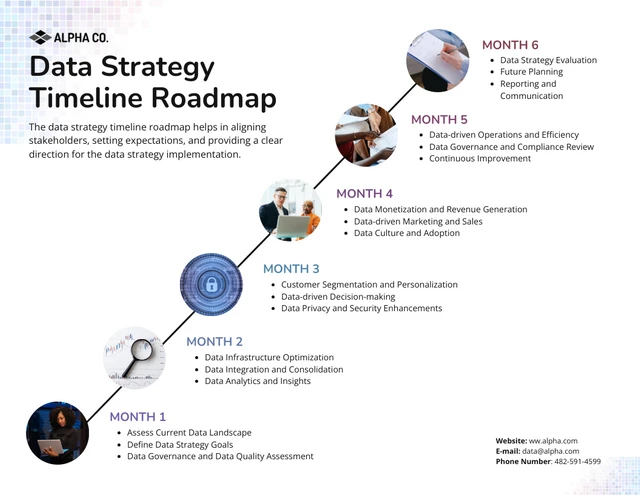
Comparison charts
Comparison chart templates can also be extremely useful in succession planning because they provide a visual way to evaluate and compare potential successors.
Comparison chart templates like in the example below can help you organize information about each candidate in a clear format and help decision-makers identify the best candidate for a leadership role.
Benefits of using Venngage
Venngage’s templates are designed by a team of designers to ensure they’re professional and engaging.
No matter the template you choose on Venngage, you’ll be able to customize it using a simple drag-and-drop interface. That’s right! You need no coding or design expertise.
Here are all the cool things you can do in Venngage:
- Replace images in templates with your own by either uploading or browsing our in-editor library of diverse images, icons, and graphics.
- Change the text, icons, or graphics within the template.
- Add your brand colors to vision boards with a single click using My Brand Kit (available only for Business users).
- Download and print templates created in Venngage (Business users only).
Succession planning success stories
We’ve gone through a lot of succession planning theory so far.
So let’s switch gear now and see real-life examples of succession planning in action at companies.
Examples of companies that have benefited from strong succession plans (and use Venngage!)
“As the CEO of Nationwide United Auto Transport, I emphasize succession planning for managerial roles as well as operational ones.
We extensively use tools like Venngage for creating visually engaging succession planning templates that are easy to understand. It facilitates seamless communication of our plans across various departments. To track our plans’ progress, we rely on regular reviews and incorporate feedback into our ongoing process. We found a notable improvement in our business resilience and continuity capacity since establishing this approach.”
Chris Estrada, CEO and Founder of Nationwide United Auto Transport.
“In my experience as a jewelry platform owner, succession planning is essential for keeping our business strong and ensuring that the relationships we’ve built with our customers continue to thrive.
To make the succession process smooth, I rely on tools like Venngage’s templates, which help me structure our plans clearly and effectively. Overall, having a solid succession plan in place has helped foster a culture of continuous improvement, preparing our business to succeed across generations.”
Joseph Seitam, Co-founder, Icecartel.
Conclusion: Don’t leave organizational success to chance and begin your succession planning journey today with Venngage
Succession planning is a positive investment that ensures an organization’s long-term success.
Small efforts and planning today will not only reap rewards down the line but help organizations avoid situations like loss of critical knowledge that may never be recovered, naming a successor who lacks personal drive, commitment, knowledge, training or skills needed to perform the job, or potential disruptions to workplace processes, workflows, and protocols.
Also, talent development has a positive side effect of boosting morale, productivity, and making your business more attractive in drawing in top talent (a positive feedback mechanism!)
Want to get started with succession planning? Check out our succession planning templates to streamline your efforts today!




























